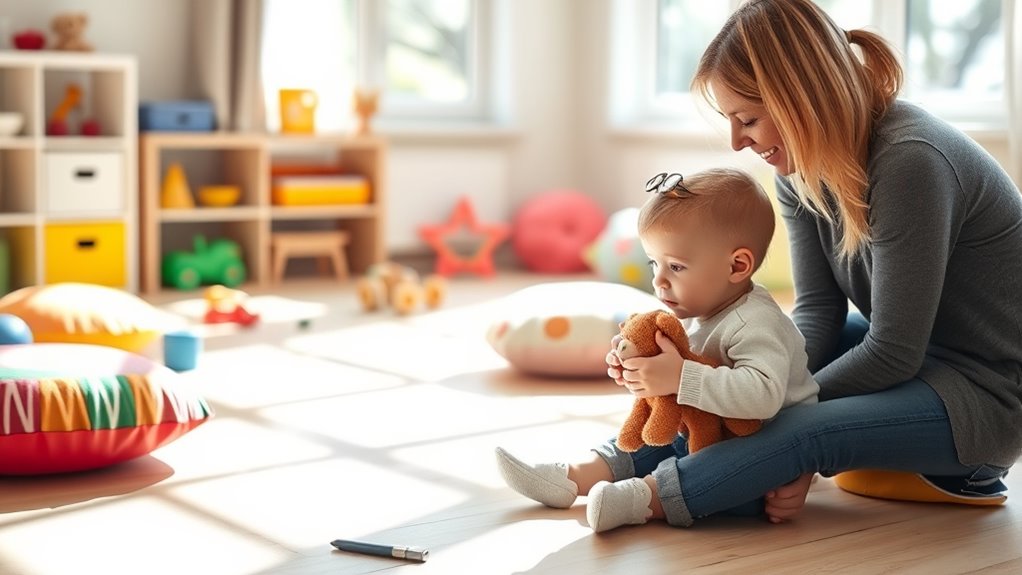To get toddlers to listen, use clear and simple commands, and try to engage them at their level by making eye contact. Timing requests, like asking them to turn off the TV after a show, can help with shifts. Incorporate playful techniques to make listening fun, and always acknowledge their positive behaviors with praise to encourage more of it. These strategies can make a big difference, and there’s plenty more to explore!
Key Takeaways
- Use simple, direct commands and provide one instruction at a time to avoid overwhelming your toddler.
- Engage at the child’s level with eye contact to foster connection and attentiveness.
- Incorporate playful elements into listening requests, turning them into fun games to encourage cooperation.
- Acknowledge and praise positive listening behaviors to reinforce and encourage repetition.
- Establish consistent routines and timing requests to help toddlers anticipate transitions and changes.

Getting toddlers to listen can feel like an uphill battle, especially when they’re deeply engrossed in play. You might notice that when your child is having fun, they often tune out any requests you make. To make shifts smoother, consider timing your requests carefully. For instance, saying, “Once that episode is done, please turn off the TV,” helps your child prepare for what’s next without feeling abruptly interrupted. This gentle approach allows them to finish their current activity while still acknowledging your request.
Using simple, direct commands is key to helping toddlers understand what you want them to do. Instead of overwhelming them with multiple instructions, give just one command at a time. When you ask your child to “put away the toys,” it’s easier for them to process and follow through. The clearer you are, the more likely they’ll be able to pay attention and respond. Remember, toddlers thrive on clarity, so keep it straightforward. Establishing a bedtime routine can also help them understand the importance of listening during structured times, much like how digital literacy programs encourage effective communication skills in seniors. Additionally, understanding that emotional and psychological growth occurs in stages can inform your approach to their listening skills.
Simple, direct commands help toddlers understand and respond better, making it easier for them to follow through on your requests.
Engaging with your child at their level can greatly boost their attentiveness. Get down on the floor, make eye contact, and speak directly to them. When they see you face-to-face, it reinforces that you’re genuinely interested in their actions and feelings. This connection makes them feel valued and encourages them to listen more closely. You’re building a rapport that says, “I see you, and what you’re doing matters.”
Incorporating playful elements can transform the listening experience into something enjoyable. You might pretend to turn on “listening ears” by cupping your hands around your ears and saying, “Okay, it’s time to use our listening ears!” This fun approach can reduce resistance and make your child more willing to engage. Kids love play, and by making listening a game, you’re inviting them to join in rather than forcing them to comply.
Lastly, don’t underestimate the power of praise. When your child demonstrates positive listening behaviors, acknowledge it! Simple affirmations like, “Great job listening!” or “I love how you turned off the TV!” encourage them to repeat those behaviors. Consistent praise reinforces their willingness to listen and helps develop better listening skills over time. Moreover, fostering an environment that promotes emotional resilience can support your child’s ability to cope with transitions and changes in activity.
Frequently Asked Questions
How Do You Discipline a Toddler Who Doesn’t Listen?
When you’re dealing with a toddler who doesn’t listen, it helps to keep things simple and consistent. Use clear, positive commands so they know exactly what to do.
Establish a routine to create predictability, making it easier for them to understand expectations. When they do listen, offer immediate praise to reinforce that behavior.
If they don’t comply, consider gentle consequences tied to their actions, helping them learn about choices without harsh punishment.
How Do I Get My Child to Listen to Me Without Yelling?
Getting your child to listen without yelling might feel like trying to teach a cat to swim—frustrating!
But there are ways to make it work. Start by getting down to their level, making eye contact, and using simple words.
Turn commands into positive requests, like “Let’s use our gentle hands!” Encourage them to repeat back what you say.
Keep your tone calm and playful, turning listening into a fun game rather than a chore!
What Causes Toddlers to Not Listen?
Toddlers often don’t listen for several reasons. They’re exploring their independence, testing boundaries, and seeking control over their environment.
Emotional states like hunger or tiredness can make them less responsive, while their engagement in fun activities often leads to selective hearing.
Communication challenges, such as misunderstandings or unclear instructions, can also contribute to noncompliance.
Additionally, factors like ADHD or ASD might complicate their listening abilities, requiring different approaches to improve their engagement.
How to Help a Toddler Learn to Listen?
Imagine planting a seed; with attention and care, it grows strong.
To help your toddler learn to listen, engage at their level—make eye contact and use their name. Keep your language simple and clear, breaking down instructions into one or two steps.
Encourage them to repeat back what you say, ensuring understanding. Add fun elements, like silly sounds, and praise their good listening to nurture their skills and confidence.
Conclusion
In the garden of parenthood, nurturing a toddler’s listening skills is like tending to delicate flowers. You plant seeds of patience, water them with gentle words, and watch as understanding blossoms. Just as every flower needs sunlight, your little one thrives on love and consistency. With each day, as you guide them along the winding path, you’ll find that those once stubborn buds will bloom into attentive listeners, creating a vibrant landscape of connection and communication.









